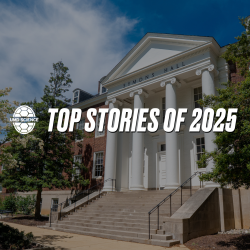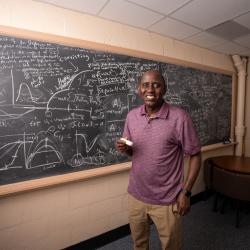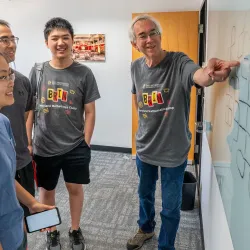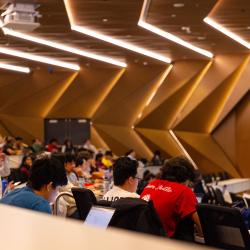Covering the Pandemic: Q&A with Alumna Gina Kolata
 Gina Kolata (B.S. ’69, microbiology; M.A. ’73, mathematics) is an award-winning journalist who has written about science and medicine for The New York Times for more than three decades. Now, Kolata is in the middle of one of the biggest stories of her career. Since March, she has chronicled the progression and impact of the rapidly changing COVID-19 outbreak for the paper, reporting on everything from the shortage of protective face masks to the search for an effective coronavirus treatment.
Gina Kolata (B.S. ’69, microbiology; M.A. ’73, mathematics) is an award-winning journalist who has written about science and medicine for The New York Times for more than three decades. Now, Kolata is in the middle of one of the biggest stories of her career. Since March, she has chronicled the progression and impact of the rapidly changing COVID-19 outbreak for the paper, reporting on everything from the shortage of protective face masks to the search for an effective coronavirus treatment.
In an email interview with UMD’s College of Computer, Mathematical, and Natural Sciences, Kolata shared her thoughts about her work and the advantage her background in science and mathematics has given her as she follows this worldwide infectious disease crisis.
You have a bachelor’s degree in microbiology and a master’s degree in math from the University of Maryland—was it always your plan to become a science journalist?
No. Like many people, I didn’t know what I wanted to do, except that I wanted it to be interesting. I didn’t think of science writing until I was ready to quit graduate school for the second time. I had already left a Ph.D. program in molecular biology at MIT because I hated lab work. When I went to Maryland, I realized I didn’t have the talent to be a creative mathematician. I wrote a master’s thesis and realized that what I really love is not research but writing.
How long have you been at The New York Times covering science and medicine, and what have been some of the highlights for you?
I came in September of 1987 and have had many highlights—two series that were Pulitzer Prize finalists (one was on the war on cancer and the other on clinical trials), covering the cloning that resulted in Dolly the sheep, covering the story of the solution to Fermat’s last theorem, writing about compelling and heart-wrenching topics, like sickle cell disease and heart disease. I could go on and on.
You’ve covered some big stories. How challenging is it to cover a story like COVID-19, and what are the aspects of COVID-19 you find most interesting?
The challenge is to not get swept up in the endless detail, but instead to focus on the big picture. The interesting aspects change from week to week.
You know a lot about pandemics—you wrote a book about another major virus outbreak, the Spanish flu of 1918—but what was it like when the coronavirus outbreak hit and you found yourself actually covering a modern-day pandemic?
It was eerie. When I wrote about the Spanish flu, I never ever thought I’d see people around the world wearing masks. I never thought society would shut down like it has and that schools would close for months.
What parallels and differences have you seen between the Spanish flu and COVID-19 outbreaks?
Parallels are the fear and shutdowns, although they did not last nearly as long in 1918. One difference is that the flu struck mostly young and middle-aged healthy people and the coronavirus preys on older people and people with serious medical conditions. Another difference is the medical support for patients and our ability to test for the virus and make a vaccine. Also, the flu had nowhere near the devastating economic impact that the coronavirus is having. In 1918, there was not widespread unemployment and the stock market only fell by 10%.
Reflecting on this experience so far, how has your background helped you in covering COVID-19 and its impact?
It’s been a huge advantage to have spent years at The Times as a medical reporter. I know lots and lots of experts whom I trust and can call upon for comments, and I have learned to quickly assess story ideas, based on my knowledge of science, medicine and medical research.
What’s been your biggest surprise as you’ve covered this story?
I did not expect such a complete and seemingly unending shutdown of society with so little weighing of costs and benefits.
As you were writing about the latest coronavirus developments and the searches for treatments, you were also dealing with the reality of the outbreak yourself in some sense—as the worst was unfolding not far away in New York City. How hard was it to “turn off” this story in your brain when you were done working for the day?
It’s easy for me. I have a life even though the world has shut down. I run. I help take care of four little grandchildren. I go for walks with my friend and just taught my 4-year-old granddaughter to ride a bike without training wheels. I live in a small town with beautiful parks and open spaces. But I miss going into the office.
What has been your most frightening or unsettling experience during this pandemic?
I have not been frightened. I am unsettled by the heartbreaking economic devastation.
What will be the most memorable thing about this experience?
The way this virus has destroyed society and ruined lives.
What’s your goal as a journalist, and as a scientist, for the stories you write?
I want to write stories so compelling that you can’t stop reading once you start.
To read Kolata's latest stories in The New York Times, visit https://www.nytimes.com/by/gina-kolata.
###
Media Relations Contact: Leslie Miller, 301-405-9267, lmille12@umd.edu
University of Maryland
College of Computer, Mathematical, and Natural Sciences
2300 Symons Hall
College Park, Md. 20742
www.cmns.umd.edu
@UMDscience
About the College of Computer, Mathematical, and Natural Sciences
The College of Computer, Mathematical, and Natural Sciences at the University of Maryland educates more than 9,000 future scientific leaders in its undergraduate and graduate programs each year. The college's 10 departments and more than a dozen interdisciplinary research centers foster scientific discovery with annual sponsored research funding exceeding $200 million.







